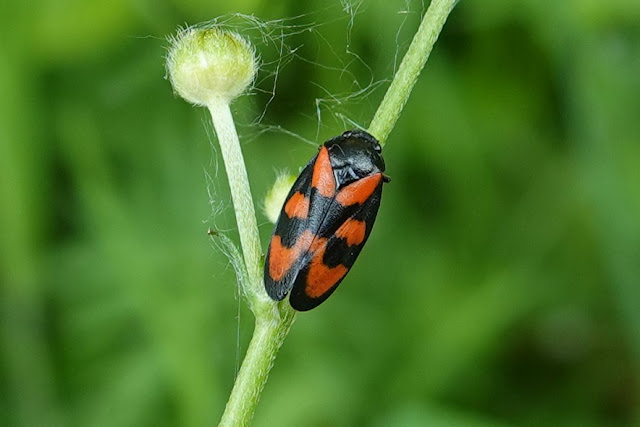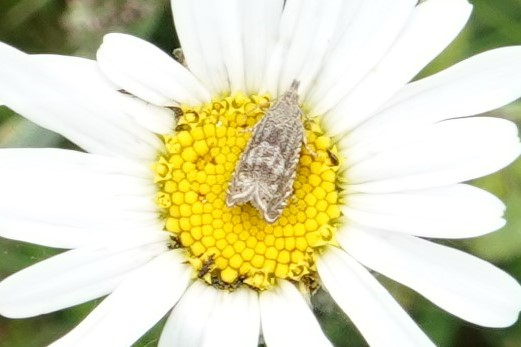I dropped my car off for its MOT just before 8am on the old
A13 near Rainham Steel which gave me about two hours to walk slowly up the
Ingrebourne Valley to my start point for my Land of the Fanns guided walk at
the Squadrons Approach car park.
It was grey and overcast but the earlier rain was at least
holding off. I walked around Albion Lake but it was too cool for any
Dragonflies. Great Crested Grebes had young and Tufted Ducks were getting
frisky while the first of three Cuckoos
was singing just to the south.
.JPG) |
| Tufted Duck |
.JPG) |
| Tufted Duck |
.JPG) |
| Some sort of naturalised Salvia I think |
I looped up alongside Ingrebourne Hill and had forgotten
just how expansive the reedbed is here at the bottom of the Valley. I could
hear plenty of Reed and Cetti’s Warblers and a couple of Reed Buntings but it
still looks perfect for Bittern, Marsh Harrier and even Savi’s Warbler. I am not sure how well watched the southern end
is by the local lads?
There were banks of Salsify in various shades of purple and
lilac and although I found yellow Goatsbeard I did not see any funky hybrid blooms.
Chiffchaffs, Blackcaps and Whitethroats were numerous and one of the latter was
repeatedly adding a single perfect Bee-eater call into its little scratchy repertoire
which was slightly worrying until I placed the ‘two’ birds together.
.JPG) |
| Goatsbeard |
.JPG) |
| Salsify |
Stock Doves were ‘wooing’ from a dead snag in the marsh and
the Dog Roses were putting on a good but currently insect free show.
.JPG) |
| Dog Roses |
.JPG) |
| Looking into the City with the biggest flock of Cranes in our area ever |
.JPG) |
| The Pioneer Market Towers in Ilford |
I took the bike path through the grassland where Skylarks
were singing but disappointingly no Meadow Pipits but was pleased to then come
across a little pocket of habitat with four singing Willow Warblers in it. I honestly can’t remember the last time I had
more than a single singer in a local context and most of those will have been transient
males.
I reached Albyns Farm where there were Geese, Mallard and a
Mute Swan brood along with a surface picking 1st-summer Black-headed
Gull and a smart Great Crested Grebe.
There were some nice patches of Ragged Robin, Gypsywort and Water Mint
around the margins and the Yellow Flag was flowering.
.JPG) |
| Egyptian Goose |
.JPG) |
| Great Crested Grebe |
.JPG) |
| Mute Swan |
.JPG) |
| Ragged Robin |
.JPG) |
| Ragged Robin |
.JPG) |
| Wandering Snail |
.JPG) |
| Yellow Flag |
I bumped into Alan from the old Rainham Wednesday Walk crew
before continuing on through a blizzard of Poplar fluff.
Once the party had assembled we set of for a slow loop back
down to the Green Bridge before swinging back up through the grassland to the
farmland and then through the oak wood and back along the river to the
cars. Despite the grey conditions it had
actually warmed up and if you took the time to look there was a wealth of
smaller wildlife to look for and between us we found a good selection of Hoverflies
including Anasymyia lineata and a full on buzzing Merodon equestris who was
pretending very successfully to be a Carder Bee.
.JPG) |
| Anasymyia lineata |
.JPG) |
| Anasymyia lineata |
 |
| Episyrphus balteatus - Alan Chown |
The scrape from the viewpoint was already very low but there were Shelduck, Gadwall, Shoveler, two Mallard broods and a single Lapwing. There were just a couple of Butterflies but we did find
Latticed Heath Moths along with a host of micros, some of which Bill Crooks has
already put names to.
.JPG) |
| Grey Heron |
.JPG) |
| Shoveler |
%20Bill%20Crooks.jpg) |
| Thistle Bell (Epiblema cirsiana) - Bill Crooks |
.JPG) |
| Psyche casta |
%20Bill%20Crooks.jpg) |
| Plum Tortrix (Hedya pruniana) - Bill Crooks |
.JPG) |
| Nettle Tap |
.JPG) |
| Latticed Heath |
%20Bill%20Crooks.jpg) |
| Common Marble (Celypha lacunana) - Bill Crooks |
There were a couple of sexy Black and Red Leafhoppers and we
saw many Scorpion Flies and a weird Snake-headed Fly which was only the second
one I have ever seen. Tiny Orb Weavers
were starting to set up shop and grow towards their autumn splendour and
Long-jawed Orbs were strung out horizontally on their webs between plants or
just lurking in slimline manner under a leaf. Several Arianella – the Cucumber
Spiders - were also found.
.JPG) |
| Arianella sp |
%20Bill%20Crooks%202.jpg) |
| Long-jawed Orb - Tetragnatha sp |
%20Bill%20Crooks.jpg) |
| Long-jawed Orb - Tetragnatha sp |
Cantharis rustica Soldier Beetles were everywhere along with
Oedemera nobilis and Hairy Shield Bug. Phil pointed out the very cool Miris
striatus on some Hawthorn. This is one
of the smartest of the Mirid bugs. I also
saw my first Pyrochroa serraticornis of the season – such a smart Beetle.
%20Bill%20Crooks.jpg) |
| German Scorpion Fly (Panorpa germanica) Bill Crooks |
%20Bill%20Crooks.jpg) |
| Green Nettle Weevil (Phyllobius sp ) Bill Crooks |
.JPG) |
| Miris striatus |
%20Bill%20Crooks.jpg) |
| Plant Bug (Closterotomus fulvomaculatus) Bill Crooks |
%20Bill%20Crooks.jpg) |
| Red-and-black Froghopper (Cercopis vulnerata) Bill Crooks |
%20Ing%20Val%20LotF%20walk%2023-5-22%20HTV%20(46).JPG) |
| Red-and-black Froghopper (Cercopis vulnerata) |
%20Bill%20crooks.jpg) |
| Red-girdled Sawfly (Macrophya annulata) Bill crooks |
%20Bill%20Crooks.jpg) |
| Red-headed Cardinal Beetle (Pyrochroa serraticornis) Bill Crooks |
%20Ing%20Val%20LotF%20walk%2023-5-22%20HTV%20(52).JPG) |
| Red-headed Cardinal Beetle (Pyrochroa serraticornis) |
There were Seven and Twenty-four Spot and Harlequin Ladybirds
with pupae and larvae seen too and Blue-tailed, Azure and Common Blue
Damselflies were hunting the grassland and verges but the only bigger species
we saw was a couple of male Banded Demoiselle.
 |
| Common Blue Damselflies - Alan Chown |
.JPG) |
| Marsh Frog - lucky to see with so much dog disturbance along the ditches |
The farmland was fairly bird free although the Skylarks were up singing and the field margin was superb (pretty sure that a job well done by Rory) with a great mix of legumes and plaintain. I found a few bits of pretty pink Sainfoin but then discovered a whole field that seem to be just that!
.jpg) |
| Sainfoin |
.JPG) |
| Despite being very similar (in fact better in many cases) in habitat to the farmland I walk in Orsett and Bulphan there were no Yellowhammers and Yellow Wagtails. I think that there is simply too much foot traffic along the few hedgelines that remain |
There were plenty of Oxeye Daisies now in bloom and amongst them were Birds Foot Trefoil, Smooth Tare and the best pea of all - the Grass Vetchling.
.JPG) |
| Grass Vetchling |
.JPG) |
| Oxeye Daisy and... |
I showed the group a variety of Umbellifers with the banks
of sweet Cow Parsley, purple spotted and strangely warm smelling Hemlock and
the best of the lot the rich pigsty hum of a fresh Hogweed flower head! The Buttercups were especially popular with
the Hoverflies and both white and blue Comfreys were attracting Bumblebees.
.JPG) |
| Cheilosia impressa on Meadow Buttercup |
.JPG) |
| Comfrey |
.JPG) |
| Wild Privet |
The same suite of Warblers from my walk up followed us around along with a singing male and bubbling female Cuckoo and Ring-necked
Parakeets were staking out most of the big old Willows that undoubtedly gave
them the best hole choices.
.JPG) |
| Ring-necked Parakeet |
A Kestrel flew over but we did not see a Buzzard at all
while Jeanne nonchalantly pointed out a Red Kite drifting purposefully west.
With rain in the air we wiggled the last river section back
to the start where the heavens waited until we were in our cars before
releasing its cargo.
.JPG)
.JPG)
.JPG)
.JPG)
.JPG)
.JPG)
.JPG)
.JPG)
.JPG)
.JPG)
.JPG)
.JPG)
.JPG)
.JPG)
.JPG)
.JPG)
.JPG)

.JPG)
.JPG)
%20Bill%20Crooks.jpg)
.JPG)
%20Bill%20Crooks.jpg)
.JPG)
.JPG)
%20Bill%20Crooks.jpg)
.JPG)
%20Bill%20Crooks%202.jpg)
%20Bill%20Crooks.jpg)
%20Bill%20Crooks.jpg)
%20Bill%20Crooks.jpg)
.JPG)
%20Bill%20Crooks.jpg)
%20Bill%20Crooks.jpg)
%20Ing%20Val%20LotF%20walk%2023-5-22%20HTV%20(46).JPG)
%20Bill%20crooks.jpg)
%20Bill%20Crooks.jpg)
%20Ing%20Val%20LotF%20walk%2023-5-22%20HTV%20(52).JPG)

.JPG)
.jpg)
.JPG)
.JPG)
.JPG)
.JPG)
.JPG)
.JPG)
.JPG)
.JPG)

.JPG)

.jpg)
.JPG)
.JPG)
.JPG)
.JPG)
.jpg)

No comments:
Post a Comment